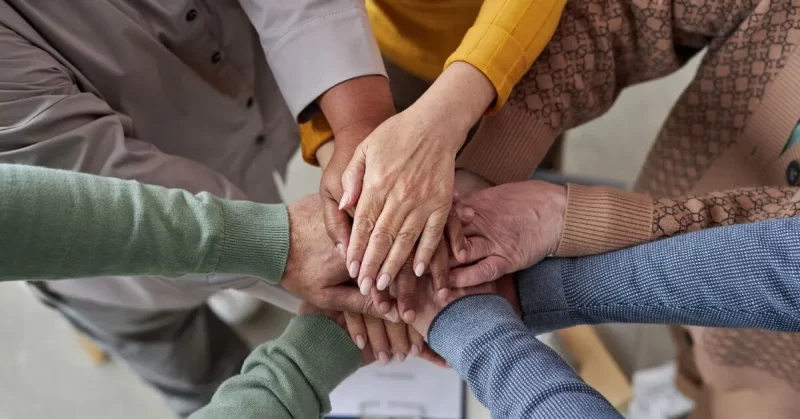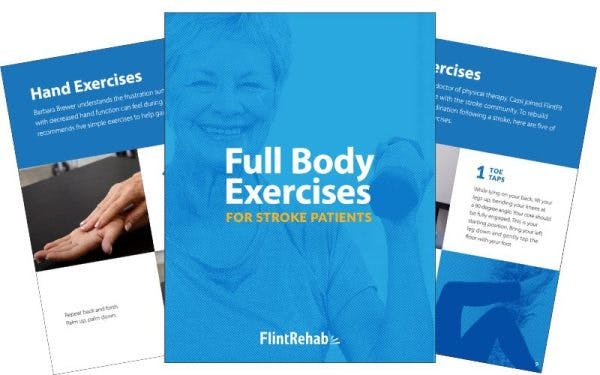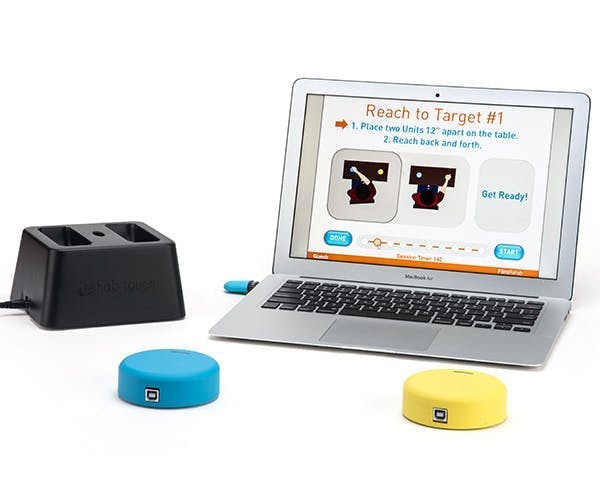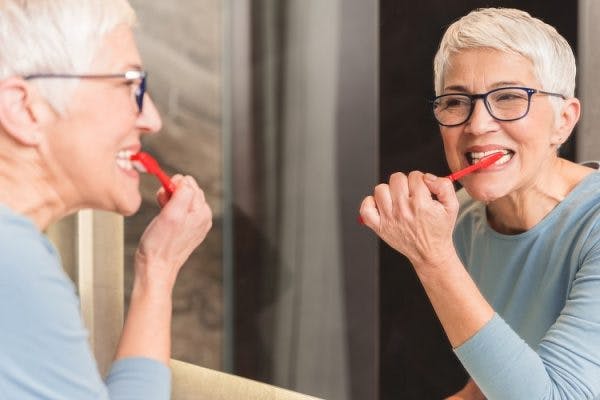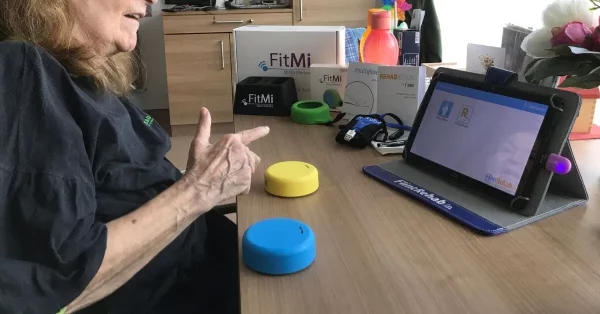Recovering from a stroke is a deeply personal journey, but it doesn’t have to be a lonely one. Joining a stroke support group can offer a sense of community, connection, and encouragement that often makes a big difference in the recovery process. Whether you’re a survivor or a caregiver, support groups provide space to ask questions, share experiences, and gain strength from others who truly understand what you’re going through.
In this guide, we’ll walk through the benefits of stroke support groups, how to find one near you, and tips for choosing between in-person or online options. We’ll also cover specialized groups for caregivers and how you can get the most out of these groups to maximize your recovery!
Jump to a section:
Why Join a Stroke Support Group
How to Find a Stroke Support Group Near You
Online vs. In-Person Stroke Support Groups
Tips for Choosing the Right Stroke Support Group
Stroke Support Groups for Caregivers
How to Get the Most Out of Your Stroke Support Group
Join the Official Flint Rehab Online Stroke Support Group on Facebook.
Why Join a Stroke Support Group?
Support groups can be an extremely valuable part of recovery for both survivors and their loved ones. Let’s take a look at a few of the top ways stroke support groups can help during recovery.
Emotional Support
A stroke can trigger a wide range of emotions including fear, frustration, sadness, confusion. Talking to others who have walked a similar path can be incredibly grounding. It helps remind you that you’re not alone, even when things feel overwhelming.
Shared Experiences and Practical Advice
Support groups can provide a wealth of knowledge from lived experience. Members often share practical tips that aren’t always mentioned by doctors whether it’s how to manage spasticity at home, deal with fatigue, or find motivation during tough days. This is invaluable for those that are just learning how to navigate recovery.
Motivation and Hope
Connecting with others who are further along in their stroke recovery can be incredibly encouraging. It reminds you that healing is a journeyand your current challenges won’t last forever. Everyone progresses at their own pace, but seeing real examples of improvement can inspire you to keep moving forward.
Reduced Isolation
Many stroke survivors, especially those with mobility or communication challenges, struggle with feelings of isolation. Regularly connecting with a group, virtually or in person, can help rebuild that sense of community.
Support groups offer a safe space to share experiences, express emotions, and feel understood by others who truly “get it.” Over time, these connections can lead to lasting friendships, renewed confidence, and a stronger emotional foundation for recovery.
How to Find a Stroke Support Group Near You
Finding the right stroke support group for your specific needs takes a bit of research. However, there are a few reliable ways to start your search.
Let’s take a look at the best ways to find a stroke support group near you!
Ask Your Care Team About Stroke Support Groups in the Area
Your hospital, neurologist, or rehabilitation center is often the best first step in finding a stroke support group. Many offer their own groups or have connections to nearby programs. In addition, they will know which groups are well-organized and active.
Another major advantage is that your care team understands your current stage of recovery and any specific challenges you’re facing. This allows them to recommend the right support groups that align with your individual needs and goals.
Talk to Other Survivors About Stoke Groups They Attend
Word of mouth can be one of the most reliable ways to find a good group. Ask fellow survivors in your therapy sessions or rehabilitation programs if they attend a group they’d recommend. Personal experiences can give you insight into the tone, structure, and value of different groups. Plus if somebody you already know is attending and recommends it then you won’t have to worry about attending alone.
Use National Resources to Search for a Stroke Support Group that Fits Your Needs
There are several national organizations that offer tools to help you locate support groups in your area or by location.
- American Stroke Association: Their online support group finder lets you search by ZIP code to find stroke-specific groups near you.
- United Way (211): Call 211 or visit their website to connect with local health and wellness services, including support groups.
Area Agencies on Aging: These agencies coordinate wellness programs and support services that often include stroke and caregiver support groups.
Check Local Community Centers
Public spaces like libraries, senior centers, and YMCAs often host health-related groups or know of nearby organizations that do. Even if the group isn’t stroke-specific, those focused on neurological conditions, caregiving, or general wellness can still offer meaningful support.
Online vs. In-Person Stroke Support Groups
Different formats work for different people. Each has its advantages and the right choice often depends on your goals and circumstances. Let’s take a look at both in person and online stroke support groups for survivors.
In-Person Groups for Stroke Survivors
Meeting face-to-face can help build trust and make communication easier, especially for those with aphasia or cognitive challenges. These groups often meet at hospitals or community centers and may include structured sessions with guest speakers or therapists. Attending in person can also be a helpful way to get out of the house and build new routines.
Online Groups for Stroke Survivors and Caregivers
For those with mobility issues or transportation limitations, online groups can be easier to attend. They also offer access to a wider range of people and topics. Some focus on specific types of stroke, age groups, or symptoms allowing you to find a community that closely matches your experience.
Online formats include:
- Video calls via Zoom or Google Meet
- Forums and message boards
- Social media groups (especially on Facebook)
Don’t be afraid to try both options and figure out what works best before settling in.
Tips for Choosing the Right Stroke Support Group
Not all support groups feel the same and different groups will be right for different people. However, here are a few universal tips that you will want to look for when choosing the right stroke support group.
- Regular meetings: A consistent schedule can help you stay engaged. This doesn’t mean you have to attend every meeting but knowing the group is active and engaged is important.
- Safe environment: Groups should feel respectful and welcoming. It is normal to feel particularly vulnerable after a stroke so finding the right environment is crucial.
- Guided structure: Facilitators (often therapists or nurses) can help keep conversations productive. Different groups will have different rules and dynamics but you will want to find one that fits what you are looking for and comfortable with.
- Relevant focus: Some groups serve specific communities like younger survivors, people with aphasia, or caregivers. Others are more general. Figure out which is most relevant for you and find a group that fits.
If the first group you try doesn’t feel like a good fit, it’s okay to try another. The goal is to find a space where you feel supported.
Join the Official Flint Rehab Online Stroke Support Group on Facebook.
Stroke Support Groups for Caregivers
Caregivers face their own set of challenges. Between managing appointments, helping with recovery, and balancing other responsibilities, the stress can build quickly. That’s where caregiver support groups can help.
Why Stroke Support Groups fro Caregivers Are Important
These groups allow caregivers to talk about their own experience, separate from the person they’re helping. It’s a safe place to talk about stress, guilt, or burnout without judgment.
Caregiver support groups can also provide:
- Strategies for daily care and scheduling
- Guidance on managing finances and medical records
- Emotional support from people in a similar role
- Information regarding available resources to help with transportation, personal care, or other needs
Where to Find Stroke Support Groups for Caregivers
- Local Hospitals or Clinics: Many run monthly caregiver-only sessions.
- Family Caregiver Alliance: Offers in-person and online group directories by region.
- Facebook and Online Forums: Search for groups using keywords like “stroke caregiver support.”
If you’re caring for someone recovering from a stroke, you don’t have to carry the responsibility alone. A support group can help you stay grounded, healthy, and informed.
Join the Official Flint Rehab Online Stroke Support Group on Facebook.
How to Get the Most Out of Your Stroke Support Group
Once you’ve found a group that works for you, here are a few ways to make the experience more meaningful:
- Show up regularly. Even if you’re having a tough week, consistency builds connection.
- Be honest. The more you share, the more likely you are to receive useful feedback and support.
- Listen actively. Others may say something that helps you see your own situation differently.
- Take notes. Bring a notebook or use your phone to jot down tips or resources mentioned.
- Give feedback. If something isn’t working in the group, let the facilitator know. They may be able to adjust or connect you with another group.
Final Thoughts: You Don’t Have to Go Through This Alone
Whether you’re adjusting to life after a stroke or supporting someone who is, finding a community can offer a lifeline. Support groups provide more than just advice they give you hope, resilience, and connection.
From in-person meetings to online forums, local gatherings to nationwide communities, there are countless ways to get involved. Start by talking to your care team, doing a little research, and testing out a few options. The right support group can make recovery feel just a bit lighter and remind you that healing is something you don’t have to do alone.
Join the Official Flint Rehab Online Stroke Support Group on Facebook.
